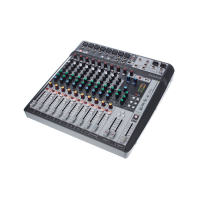
Do you have a question about the SoundCraft Signature 10 and is the answer not in the manual?
| Channels quantity | 10 channels |
|---|---|
| Product color | Blue |
| USB 2.0 ports quantity | 4 |
| Depth | 313 mm |
|---|---|
| Width | 380 mm |
| Height | 113 mm |
| Weight | 4960 g |
Crucial safety guidelines to follow before operating the mixer for the first time.
Details on EMC, LVD, FCC, and Canadian interference regulations applicable to the equipment.
Explains the EQ's intuitive design and how it works musically for tonal shaping.
Details the high, mid, and low frequency bands, including their fixed/swept frequencies and behaviour.
Explains caution and warning symbols used in the manual to highlight important information.
Emphasizes the necessity of earthing and provides color-coding for mains lead wires.
States that internal power supply has no user-serviceable parts and requires qualified engineers.
Covers safe practices for cleaning, ventilation, avoiding heat, water, and proper plug usage.
Warnings regarding rain, moisture, liquid spills, naked flames, and ventilation obstruction.
Guidance on protecting hearing, especially when monitoring through amplifiers or headphones.
Details Class A digital device compliance with FCC Part 15 and Canadian Interference Regulations.
Defines terms for warranty claims, including proper installation, notification, and authorized service.
Details frequency response, THD, noise, and crosstalk characteristics of the mixer.
Provides technical data on input/output voltage levels and impedance values.
Outlines USB audio capabilities, including bit depth and sampling rates for different models.
Illustrates the signal path through gain, HPF, EQ, and limiter stages.
Details routing options to Aux, Master Stereo (MST), and Group buses.
Illustrates the signal path through trim, HPF, and EQ for stereo inputs.
Details routing options to Aux, Master Stereo (MST), and Group buses.
Introduces the controls specific to mono input channels, referencing section 5.1.1.
Introduces the controls specific to stereo input channels, referencing section 5.1.2.
Explains the 48V phantom power button for microphone inputs.
Details the dbx limiter function and the gain reduction indicator LED.
Explains the Hi-Z switch for high impedance sources like guitar pickups.
Describes how to adjust the input gain level and the associated peak LED.
Details the function of the High Pass Filter for reducing low frequencies.
Describes the high frequency shelving EQ band and its control.
Details the mid-range EQ frequency and level adjustments.
Describes the low frequency shelving EQ band and its control.
Explains how to control the channel's contribution to auxiliary buses and the FX processor.
Explains the function of the Peak and Mute indicator LEDs on the channel strip.
Describes the channel fader for adjusting signal level and its role in mixing.
Explains routing channels to the Master Stereo (MST) bus.
Adjusts the input level for stereo line-level sources.
Controls the channel's contribution to auxiliary buses and the FX processor.
Allows post-fader switching for Aux 1 and 2 on the Playback Channel.
Adjusts stereo position (Pan) or relative levels (Balance).
Adjusts the relative levels of left and right signals for stereo balance.
Routes the stereo channel's output to Group 1 and 2 buses (Signature 12/12MTK).
Fast way to mute all channels except the playback channel (e.g., for interval music).
Enable pre-fade listening to input channels, sending signal to the Solo Bus.
Enables direct outputs from input channels and return of USB audio to input channels.
Check input validity and work through the signal path to find signal 'breaks'.
How to check if a solo is active and mute other channels, and how to clear them.
Verify signal path to Solo Bus and check Mute, fader, and routing selections.
Ensure master controls for routed buses have adequate levels.
Check FX send, processor, and return stages for proper signal flow.